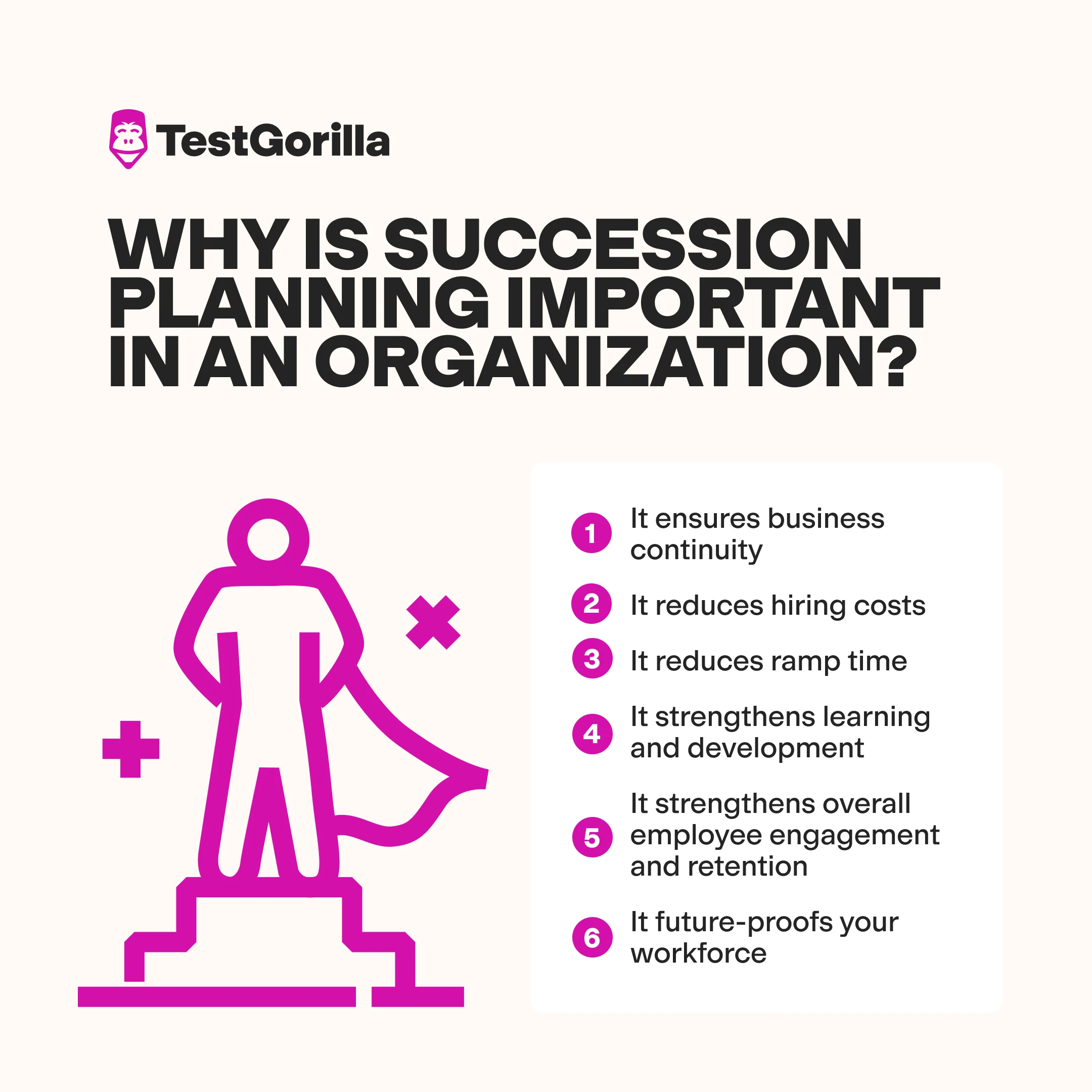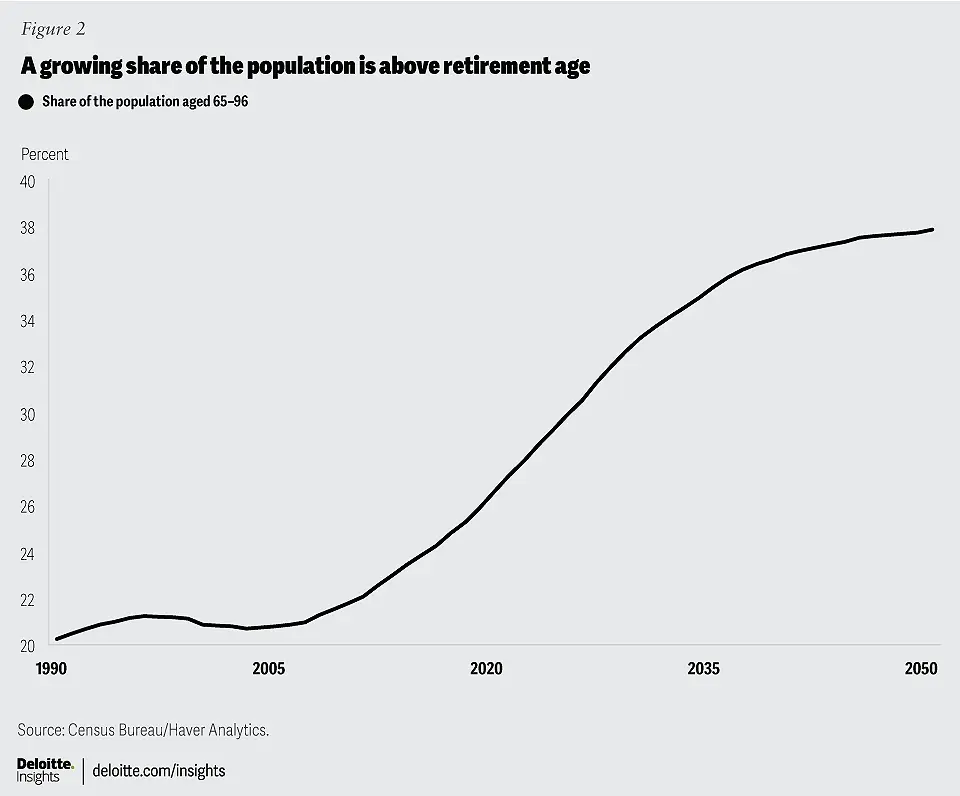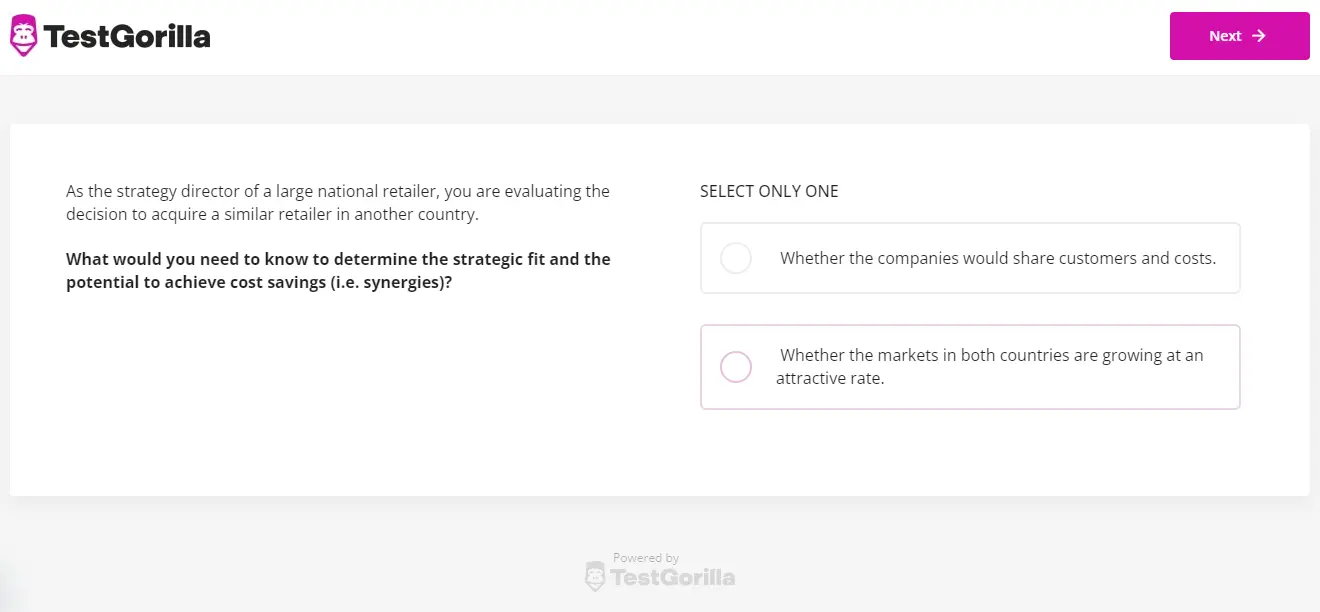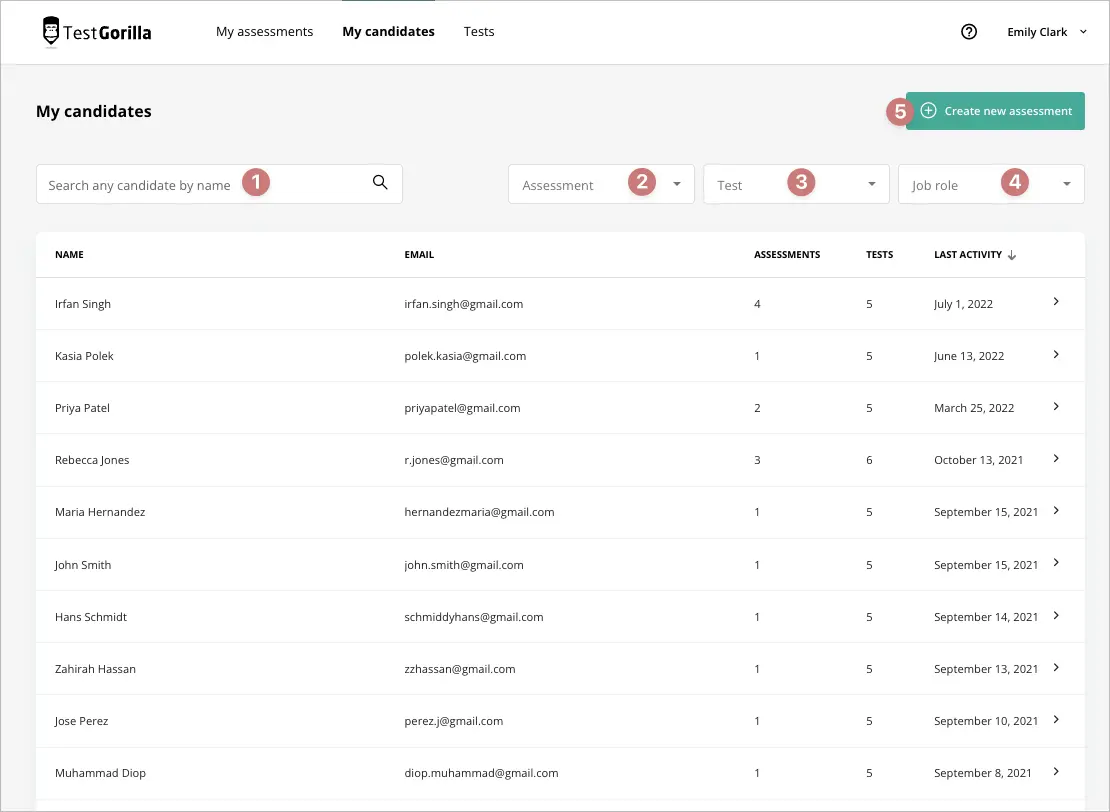The ultimate guide to succession planning tools
Don’t wait to find out the skills you need
Filling open roles quickly has always been a core responsibility for human resources.
But this HR fundamental is easier said than done, especially in cases where:
The vacancy is unexpected
The person leaving has irreplaceable industry or company knowledge
The necessary skills are in short supply in the market
If you wait until you receive a resignation or retirement notice, you’ve already lost time.
That’s where succession planning tools come in. Succession planning software tools help you prepare for vacancies in mission-critical roles before they happen.
Here’s how it works.
Table of contents
- What is succession planning?
- Why is succession planning important in an organization?
- The top 5 succession planning tools
- Succession planning guide: 5 steps for success
- How can you use TestGorilla for successful succession planning?
- Supercharge your succession planning tools with TestGorilla
- Succession planning tool FAQs
What is succession planning?
Succession planning is the process of identifying employees with key leadership skills and preparing them to take over management roles within a company. Having a succession plan helps ensure that capable individuals are in place to take on leadership positions when current managers retire, leave, or step away from their posts for any other reason.
The process involves preparing for situations where an employee unexpectedly decides to leave. It means ensuring your talent is prepared to fill the key position of the staff member who has left.
Succession planning also helps you develop future leaders who can provide fresh perspectives for your business and help drive innovation.
Why is succession planning important in an organization?
Many leaders have spoken about the importance of succession planning. Here’s why it’s non-negotiable for your company:
It ensures business continuity. Having a “next in line” candidate reduces the length of vacancies and, therefore, the burden on your teams to compensate.
It reduces hiring costs. The hard work of defining key skills and identifying potential candidates is done before their seat is even cold, reducing time-to-hire.
It reduces ramp time. As much as 42% of valuable company knowledge is unique to the individual employee; creating a succession plan gives your firm a head start on handing over this knowledge to their successor.
It strengthens learning and development. Identifying important skills for top roles not only gives you a guideline for employee training; it also incentivizes employees to get involved and empowers them to plan their career paths.
It strengthens overall employee engagement and retention. Preventing cracks in your leadership prevents dissatisfaction further down the company structure: McKinsey research found that high-quality leadership correlates with higher retention.
It future-proofs your workforce. The US workforce is aging rapidly; you need to be prepared for workers to retire and for the difficulties of external hiring in a market with slow labor force growth.
The top 5 succession planning tools
We’ve seen why it pays to have talent planning strategies in place. But what succession planning software tools help you access these benefits?
We’ve compiled a list of the five best succession planning software on the market. The pricing shown is accurate at the time of writing.
1. TestGorilla: Best for using talent assessment tools for succession planning
Although not strictly a succession planning tool, TestGorilla can help you manage succession planning by enabling you to:
Objectively assess employees’ skills. You can identify employees with the potential to become your company’s next generation of leaders. Our assessments objectively evaluate employees’ skills, and you can use this data to create a succession plan.
Follow employees’ skill progression. Continuously testing and evaluating employees shows you how their skills and knowledge are developing. With this information, you know who is most suited for a future leadership role.
Gain a clear overview of talent gaps and development opportunities at the company level. You can assess underdeveloped skills and create training programs to help your employees strengthen those abilities. You may also want to do a more detailed skills-gap analysis of your current talent pool.
This works for organizations of any size, including those scaling their hiring.
User review score on G2: 4.5/5 stars
Pricing: Our monthly plans start at $75 per month and enable you to host unlimited active assessments for an unlimited number of candidates.
To try TestGorilla 100% commitment-free today, sign up for a Free Forever plan!
2. SAP SuccessFactors: Best for companies looking for an all-in-one HR software that includes succession management tools
SAP SuccessFactors helps you identify, develop, and retain your high-value employees. This software’s toolkit includes:
Organizational charts. You can quickly see key indicators, such as the risk of loss and talent gaps.
Coaching and mentoring. This helps you plan and provide ongoing career development.
Talent search. You can identify hidden top talent with a company-wide search for critical skills and talents.
In addition, the integration of analytics tools helps you make objective decisions based on accurate data.
User review score on G2: 3.9/5 stars
Pricing: SAP SuccessFactors succession planning software is priced as an add-on at $22.92 per user per month. Pricing for the overall HR management system is not transparent online.
3. PerformYard: Best for performance management
PerformYard is performance management software ideal for annual reviews, quarterly goals, and continuous feedback.
This succession planning platform can support succession planning by identifying high-value employees and streamlining their learning process. The software is customizable and useful for 360-degree reviews, which can facilitate conversations between you and your employees.
This tool helps you understand your employees’ learning and development needs. Based on this information, you can create a personalized development program that is aligned with your company goals and succession plan.
User review score on G2: 4.8/5 stars
Pricing: Pricing is based on the number of employees, usually $5-$10 per person per month. Detailed quotes available on request.
4. Cornerstone OnDemand: Best for user-friendly succession management tools
When used in conjunction with Cornerstone Performance, Cornerstone’s succession planning software tools can match qualified internal candidates to open roles.
Cornerstone’s Learning and Development (LMS) tool enables you to create personalized virtual modules or in-person training that’s flexible depending on your needs. Their analytics tools streamline real-time insights into employees’ performances.
This succession planning platform has a unified interface where you can assign tasks, track progress, and identify skills gaps. In addition, the app facilitates learning anywhere, anytime – even on your phone.
User review score on G2: 4.4/5 stars
Pricing: Available on request.
5. PeopleFluent: Best for creating career plans
PeopleFluent’s succession planning software, used by small and large enterprises, can help you find new leaders or upskill current employees to fill critical roles in the future.
You can use the tool to create a fact-driven succession plan using data and analytics to understand your internal candidate pipeline.
This succession planning tool gives users the power to track and map competencies against goals for annual reviews, encouraging employees to be engaged in their own progression.
User review score on G2: 3.9/5 stars
Pricing: Available on request.
Succession planning guide: 5 steps for success
We’ve given you our shortlist of the best succession planning software tools, but that’s not enough to create a strong leadership pipeline.
To succeed with succession plans, you need to follow a few important steps.
For a more in-depth guide to succession planning, read our blog post about succession planning best practices.
1. Use succession planning tools to take stock of your succession needs
Once you have your tools in place, the first step in our succession planning guide is to start assessing your organization’s succession needs. This involves monitoring and evaluating various factors. For this, you need to:
Track retention rates
Monitor turnover rates
Keep an eye on recruitment stats, such as cost-per-hire and time-to-hire
Monitor in-house succession and external candidate succession
Address diversity and inclusion when planning for succession
Monitoring these factors helps hiring managers plan in advance and be able to appoint the best candidate or employee. It also makes it easier to optimize the recruitment process and save on recruitment costs.
2. Plan ahead
When creating your succession plan, you need to think of both the short and long-term future.
Ask yourself the following questions:
Do any of our current leaders plan to retire or leave the company soon?
Do you have the right people to take over those leadership positions?
Who will best fit in those roles, and do they possess the right skills and knowledge?
Do they need additional training?
If someone is retiring soon and you have no one to replace them, you may have to source a candidate from outside your company or create a crash course for an employee to fill the position.
3. Identify high-potential employees and train them to meet future needs
The next step of your talent management strategy is to identify your most qualified employees and the ideal candidates for a leadership position.
The top management skills leaders need are:
Excellent communication
The ability to delegate tasks
The ability to listen, offer advice, and give feedback
Willingness to take on responsibility
Capacity to work under pressure with tight deadlines
You can use TestGorilla’s talent assessment tools for succession planning to identify candidates that have these.
For example, when hiring a web developer, you could use our succession planning assessment tools to evaluate soft skills like project management and role-specific skills tests to gauge their coding ability.
Once you pinpoint an ideal candidate, you can start mentoring them or enroll them in a special training course to further develop their skills in preparation for their future leadership role.
Creating a plan and identifying potential leaders within your company enables you to align the development of your employees with the company’s needs.
4. Use skills-based hiring to get external succession right
Even the best succession planning software tools can’t create skills where there are none. In these cases, external hiring is your only choice.
Skills-based hiring with testing platforms like TestGorilla reduces the bias that keeps great candidates from jobs.
One study of more than 2,000 successful job placements found the number of women hired into top roles increased by nearly 70% when a skills-based hiring method was used.
Skills tests are also more accurate than pre-hire work experience, which has been proven to be a poor predictor of job performance and retention.
5. Continuously re-evaluate your succession plan
A succession planning strategy is not a “one and done” process. It is one that requires frequent re-evaluation and upkeep to keep it up-to-date.
The best succession planning software tools help you do this by integrating closely with your:
Learning management systems
Performance management systems
Internal talent marketplace
You should also schedule dedicated review sessions for your HR and leadership teams, as well as other key stakeholders, to review your succession plans and identify any new roles that may become essential to your mission.
How can you use TestGorilla for successful succession planning?
Here’s how to use TestGorilla’s talent assessment tools for succession planning.
1. Choose skills tests that are created by experts
The first step is selecting the right assessments to conduct a comprehensive evaluation. Choose tests from a number of categories, such as:
Personality tests
Cognitive ability tests
Situational judgment tests
Role-specific tests
Select the skills tests that assess the skills you would like to analyze. If you are hiring for a senior leadership role, for example, you might select a Leadership and People Management test.
You should also consider including tests to evaluate their decision-making ability, such as an assessment on business ethics and compliance.
We also offer situational judgment tests like our Business Judgment test to dig into difficult areas of leadership decision-making. Here’s an example question:
All of TestGorilla’s skills tests have been created by subject matter experts. Even if you’re not an expert yourself, you can test your candidates in any area, including leadership, and receive reliable results.
To find out how it could work for you, book a demo with one of our experts today.
2. Receive and compare the results
If you are unsure which successor to select, TestGorilla lets you compare the test results of all candidates. You can select from grouped or individual comparative options.
A grouped comparison lets you compare your candidates’ results, whereas the individual option lets you compare all test results for one candidate.
3. Assess candidates’ future performance potential and choose the right successor
Getting a precise understanding of a candidate’s skills enables you to look ahead and see how they will fit into the role.
This is possible with TestGorilla because you can use the results to see how they could develop in the future. You can then choose the right candidate for the position and track their progress in the future by using talent assessment tools for workforce planning.
Supercharge your succession planning tools with TestGorilla
In this article, we’ve shown you that you don’t have to wait for a vacancy to pop up before you start planning how to fill a role.
With skills testing and other succession planning tools, you can identify skills gaps, find potential successors, and make the right call between internal and external candidates.
Don’t wait to get started. Take a product tour of TestGorilla today or book a demo with one of our experts to see how our skills tests could work for you.
Or, if you want to try out a few tests for yourself, sign up for our Free Forever plan.
Succession planning tool FAQs
Do you have burning questions about succession planning tools & templates? Here are answers to common queries.
How do you create a basic succession plan?
Creating a basic succession plan starts with identifying mission-critical positions – those employees whose absence, whether planned or unplanned, would impact your ability to meet your organizational goals.
You then need to identify potential successors for these roles. The best way to do this is with a skills-testing platform like TestGorilla.
What are the five steps to succession planning?
There are five basic steps to creating a succession plan:
Take stock of your succession needs and identify critical roles
Plan ahead based on your organizational goals
Identify high-potential employees with skills testing and train them to meet future needs
Use skills-based hiring to get external succession right
Continuously re-evaluate your succession plan
What is the most critical step in a succession planning process?
The most important step in succession planning is identifying employees who have the potential to step into key roles, followed by training or onboarding them with custom professional talent development plans to augment their existing skills and excel in the role.
Skills testing is the best way to tailor these professional development plans to candidates’ needs.
What are succession planning examples?
Examples of the methods and initiatives used for effective succession planning include:
Using skills testing to evaluate the skills within your workforce
Crafting professional development plans for high-potential employees
Offering mentorship and dedicated training to improve employees’ skill sets
Using skills-based hiring to choose the right external candidates
Using succession planning tools to organize and analyze these metrics
Related posts
Hire the best candidates with TestGorilla
Create pre-employment assessments in minutes to screen candidates, save time, and hire the best talent.
Latest posts
The best advice in pre-employment testing, in your inbox.
No spam. Unsubscribe at any time.

Hire the best. No bias. No stress.
Our screening tests identify the best candidates and make your hiring decisions faster, easier, and bias-free.
Free resources
This checklist covers key features you should look for when choosing a skills testing platform
This resource will help you develop an onboarding checklist for new hires.
How to assess your candidates' attention to detail.
Learn how to get human resources certified through HRCI or SHRM.
Learn how you can improve the level of talent at your company.
Learn how CapitalT reduced hiring bias with online skills assessments.
Learn how to make the resume process more efficient and more effective.
Improve your hiring strategy with these 7 critical recruitment metrics.
Learn how Sukhi decreased time spent reviewing resumes by 83%!
Hire more efficiently with these hacks that 99% of recruiters aren't using.
Make a business case for diversity and inclusion initiatives with this data.


























